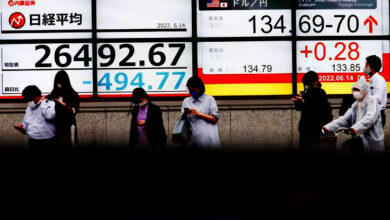Asia stock losses worsen after China’s GDP figures are released.

Asia’s stock market losses got worse on Tuesday after China released weak economic data for the fourth quarter. However, investors’ hopes for a strong rebound in the country remained high, even as worries about a global recession grew.
At 5:12 GMT, FTSE futures are up 0.02%, which means that London will open flat. E-mini futures for the S&P 500 index were down 0.31 percent, which means that the market will open lower on Tuesday after the holiday on Monday.
At 5:35 a.m. GMT, MSCI’s measure of Asia-Pacific stocks outside of Japan was down 0.65%.
Related: Asia stocks went up because of bets on the Fed rate, and the yuan went up because China reopened.
The Hang Seng Index in Hong Kong fell 1.22 percent, and China’s benchmark CSI300 Index fell 0.27 percent. This was because investors sold gains before the Lunar New Year holiday, which starts on January 21.
China’s economy grew 2.9% in the fourth quarter of 2022 compared to the same time last year, according to data released by the National Bureau of Statistics on Tuesday. This was better than expected, but it still shows the cost of a strict “zero-COVID” policy.
The official goal for growth in 2022 was about 5.5%, so 3.0% was a long way below that. Except for a 2.2% growth after COVID-19 hit for the first time in 2020, it was the worst performance in almost 50 years.
Redmond Wong, a Greater China market strategist at Saxo Markets Hong Kong, said, “I think investors will look past the Q4 GDP numbers and focus on 2023.”
“Chinese media say that more than half of the 31 provinces and cities that have released work plans for 2023 are aiming for growth of more than 5.5% in that year.”
Vishnu Varathan, who is in charge of economics and strategy at Mizuho Bank’s Asia and Oceania Treasury, said that China’s comprehensive policy commitment to build real confidence in the private sector still has a ways to go.
“Until then, ‘China cheer’ may be an opportunistic bull trade that is subject to reality checks along the way,” Varathan said.
After two days of big losses, Japan’s Nikkei 225 index went up 1.28 percent. This was because the yen’s steady rise stopped right before the Bank of Japan (BOJ) made a very important policy decision.
The BOJ is under pressure to change its interest rate policy as soon as Wednesday. This is because the central bank’s attempt to buy itself some breathing room backfired, giving bond investors the confidence to test its resolve.
On Tuesday, the dollar moved away from lows that hadn’t been seen in a few months, while the yen was sitting near highs that hadn’t been seen in seven months.
After hitting a seven-month high on Monday, the S&P/ASX 200 in Australia went down by 0.09% at the end of the day.
The pan-European STOXX 600 closed up 0.5% at 454.6, which was its highest level since April 2022. This was because global equities continued to build on a New Year rally that was fueled by hopes of a rebound in China’s economy and an ease in price pressures in the US and Europe.
“How quickly inflation will go down and whether or not major economies will be able to avoid hard landings are at the heart of the early 2023 financial market debate,” ANZ analysts said in a research report on Tuesday.
The report said, “The drop in inflation in the U.S. is good news, but the fly in the ointment is that this drop is mostly due to lower prices for energy and goods.”
“Annual service inflation in the U.S. keeps going up, and it’s likely to stay high as long as the supply-demand mismatch in the labour market lasts,” the report said.
Two-thirds of private and public sector chief economists surveyed by the World Economic Forum in Davos expected a global recession this year, with 18% calling it “extremely likely.” This is more than twice as many as in the last survey, which was done in September 2022.
Related: Asia stocks stopped losing for five days after Wall Street rose.
U.S. crude fell 0.69 percent to $79.32 per barrel, making up for some early losses. Brent, on the other hand, rose 0.25 percent to $84.67 per barrel, which is still close to their highest levels this month. This is because China eased COVID-19 restrictions, which gave people hope that demand in the world’s biggest crude importer would rise again.
At $1911.36 per ounce, spot gold was down 0.34 percent.





